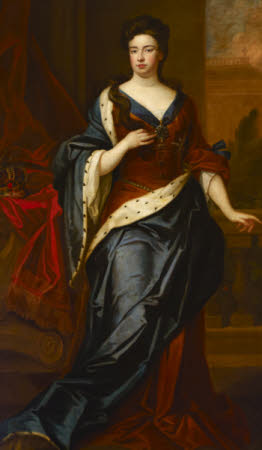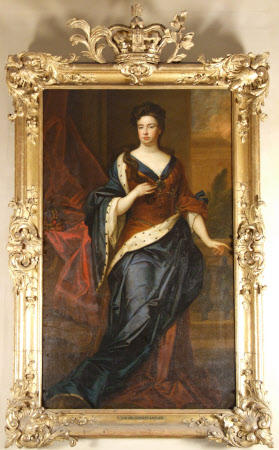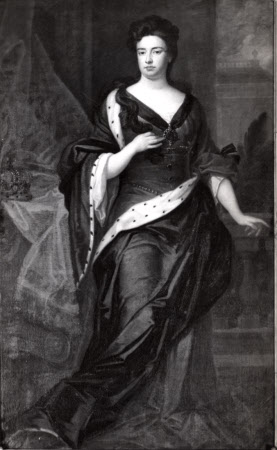Queen Anne (1665-1714)
Sir Godfrey Kneller (Lübeck 1646 - London 1723)
Category
Art / Oil paintings
Date
circa 1705
Materials
Oil on canvas
Measurements
1970 x 1180 mm
Order this imageCollection
Petworth House and Park, West Sussex
NT 486219
Caption
The Beauty Room, where this picture hangs, was devised by the 6th Duke as a tribute to Queen Anne and the ladies of her court. It was used by him as a dining-room. The ducal cipher and coronet are on a carved wood panel over the Grand Staircase entrance. The Duke served the Queen as Master of the Horse (1702-11/12), while the Duchess was Groom of the Stole (1711-14). The portraits were probably inspired more directly by the set of full-lengths of "the principal ladies attending upon her Majesty", commissioned by the Duchess's close friend, Queen Mary, from Sir Godfrey Kneller c.1690 and known as the 'Hampton Court Beauties'. All but one of the Petworth paintings are by Michael Dahl, a Swede whom the Duke employed on other work in 1695, 1708 and 1713. The set was completed by a portrait of the Duchess of Marlborough by Kneller, who also painted this portrait of the Queen.
Summary
Oil painting on canvas, Queen Anne (1665–1714) by Sir Godfrey Kneller (Lübeck 1646/9 - London 1723), signed: G.Kneller ft., circa 1705. A full-length portrait, standing, full face, with her right hand on her chest, on which is pinned the Garter badge. She is wearing a deep tawny-gold dress and an ermine-lined blue mantle. Her crown is to the left and on the wall behind a figure and sky to the right. The room was devised by the 6th Duke as a tribute to Queen Anne and the ladies of her court, and was used by him as a dining-room. The ducal cipher and coronet are on a carved wood panel over the Grand Staircase entrance. The Duke served the Queen as Master of the Horse (1702-11/12), while the Duchess was Groom of the Stole (1711-14). The portraits were probably inspired more directly by the set of full-lengths of "the principal ladies attending upon her Majesty, or who were frequently in her Retinue", commissioned by the Duchess's close friend, Queen Mary, from Sir Godfrey Kneller c.1690 and known as the 'Hampton Court Beauties'. All but one of the Petworth paintings are by Michael Dahl, a Swede whom the Duke employed on other work in 1695, 1708 and 1713. The set was completed by a portrait of the Duchess of Marlborough by Kneller, who also painted the portrait of the Queen. They must have been painted after the fire of 1714, which gutted this part of the house, and probably before 1718-20, when Laguerre was painting the adjoining Great Staircase. The 1749/50 and 1764 inventories record the portraits as in this room, with the exception of Queen Anne's portrait, which, curiously, was not listed. However, the inventories show that all bar the two over-doors were hung lower, surmounted by smaller paintings after the Italian sixteenth-century artist Polidoro da Caravaggio.Between the paintings were tall narrow bolection-moulded panels with '3 plates of Silver'd Glass in each'. The frame of the 'Pier Glass Circular Top' between the windows was part of this scheme, but it has lost its original glass 'with 4 Plates'. According to George Jones's biography of the sculptor Sir Francis Chantrey, the Beauty Room remained unaltered until the late 1820s, when the 3rd Earl of Egremont decided to create a shrine to Napoleon and Wellington here, hanging Jones's depictions "of the battles of Vittoria and Waterloo, with the bust of the Duke of Wellington [1828, by Chantrey] between them". He asked Chantrey 'about the best light for the pictures' and was told that:the most favourable [wall] was occupied by three large whole-length portraits, fixed in the panels; upon which his lordship said, "We;;, I will put them there, and your bust of the Duke in the centre. Chantrey then observed that the three portraits must in that case be removed. "No," said the Earl, "I have no place for them." "What then is to be done?" was the natural question; to which the Earl answered, "I will cut off their legs, I do not want their petticoats; their heads shall be placed in three small panels above, and the battles with the marble bust of the Duke shall be placed below them; and this was done."These alterations were apparently already in train by 1826, when the estate yard accounts refer to 'Preparing and fixing the panels in the Beauty Room. The Beauties legs were not in fact 'cut off', but rolled up to reduce their length. In the course of the room's restoration in 1995-6, the portraits have received essential conservation treatment. Pending the longer-term possibility of restoring the paintings to full-lengths and reinstating the 6th Duke's original Beauty Room, the room has been redecorated and rehung in accordance with the 3rd Earl's Napoleonic scheme.
Provenance
In the collection of the 6th Duke of Somerset (1662-1748) when seen by George Vertue in 1738. Thence by descent, until the death in 1952 of the 3rd Lord Leconfield, who had given Petworth to the National Trust in 1947, and whose nephew and heir, John Wyndham, 6th Lord Leconfield and 1st Lord Egremont (1920-72) arranged for the acceptance of the major portion of the collections at Petworth in lieu of death duties (the first ever such arrangement) in 1956 by H.M.Treasury.
Credit line
Petworth House, The Egremont Collection (acquired in lieu of tax by HM Treasury in 1956 and subsequently transferred to the National Trust)
Marks and inscriptions
G.Kneller ft
Makers and roles
Sir Godfrey Kneller (Lübeck 1646 - London 1723), artist
References
Ingamells, 2009: John Ingamells, Later Stuart Portraits 1685-1714, National Portrait Gallery, London, 2009, p. 12


